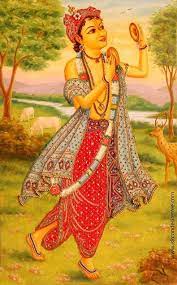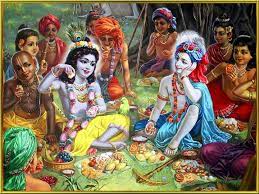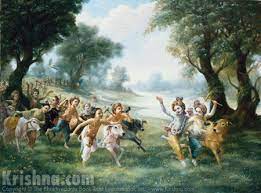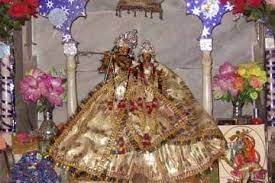The first Gaura Purnima Festival at ISKCON Mayapur was celebrated on Srila Prabhupada’s order in 1972. Though not widely attended by International devotees, it set the standard for an annual festival that has since become the backbone of annual Vaishnava sanga and celebrations in Mayapur and Vrindaban attracting hundreds of thousands of devotees. This year is the 50th Anniversary of this important festival.
1972 also is an important year because three other important events took place in Mayapur:
- 50th Anniversary of Chota Radha Madhava’s arrival
- 50th Anniversary of Prabhupada placing Ananta Sesha in the TOVP foundation pit
- 50th Anniversary of Jananivas as Head Pujari in Mayapur
Additionally, it is the 100th Anniversary of Srila Prabhupada receiving the order to preach in the West from Bhaktisiddhanta Saraswati in 1922. We have created a special year-long campaign around this event called the Paschatya Desha Tarine Centennial.
All the above five events will be celebrated at one grand festival in Mayapur from March 2-5 and devotees are invited to come and participate or watch live on MayapurTV. Find out more about the Radha Madhava Golden Jubilee Festival and also sponsor an Abhisheka, Radha Madhava Brick or Prabhupada Medallion to offer your seva and also support TOVP construction.
Below are some relevant quotes from Srila Prabhupada about the importance of the Gaura Purnima Festival in Sridham Mayapur, and a small collection of photos from the first 1972 festival:
I especially wanted to stay in India for this Mayapur celebration. Such festivals should be held very grandly. So I think you should plan that we shall definitely be coming to Mayapur and hold a grand festival there for Lord Caitanya’s Appearance Day celebration.
Letter to Jayapataka Maharaja – January 21, 1972
The best time and place is Mayapur on Lord Caitanya’s Appearance Day. That is not only the best for me but for everyone. Mayapur is meant for that. If possible all devotees from all our centers should go for 8 days at that time.
Letter to Tamala Krishna Goswami – July 20, 1973
I am very anxious to know whether we are going to have our Mayapur function (Gaur Purnima)? I want very much to hold this function this year with all of my students and I ask you to kindly serve me by making this possible. It is a very important day and it will be a great service to Srila Bhaktivinoda Thakura. So please arrange for this program.
Letter to Jayapataka Maharaja – January 5, 1972
The members of the International Society for Krishna Consciousness should go to India during the birthday ceremony of Lord Caitanya Mahaprabhu at Mayapur and perform sankirtana congregationally. This will attract the attention of all the important personalities in India, just as the beauty, bodily luster and sankirtana performance by the associates of Sri Caitanya Mahaprabhu attracted the attention of Maharaja Prataparudra.
Caitanya Caritamrta – Madhya 11.96
SPECIAL ANNOUNCEMENT
The TOVP Announces – Radha Madhava Golden Jubilee Festival, March 2 – 5, 2022
Celebrating 5 Anniversaries in 1 Festival
The TOVP Team is pleased to announce the upcoming, all-auspicious Radha Madhava Golden Jubilee Festival from March 2 – 5, 2022. This will be a festival to top all festivals, commemorating the anniversary of five important events in the history of ISKCON:
- 50th Anniversary of Chota Radha Madhava’s Installation
- 50th Anniversary of the ISKCON Mayapur Gaur Purnima Festival
- 50th Anniversary of Prabhupada Laying the TOVP Cornerstone
- 50th Anniversary of Jananivas Prabhu as Mayapur Head Pujari
- 100th Anniversary of Prabhupada Receiving Bhaktisiddhanta’s Order
For more information and to sponsor an Abhisheka, Radha Madhava Brick or Prabhupada Medallion, visit the Radha Madhava Golden Jubilee Festival page on the TOVP website.
TOVP NEWS AND UPDATES – STAY IN TOUCH
Visit: www.tovp.org
Support: https://tovp.org/donate/
Email: tovpinfo@gmail.com
Follow: www.facebook.com/tovp.mayapur
Watch: www.youtube.com/c/TOVPinfoTube
View at 360°: www.tovp360.org
Twitter: https://twitter.com/TOVP2022
Telegram: https://t.me/TOVP_GRAM
WhatsApp: https://m.tovp.org/whatsapp2
Instagram: https://m.tovp.org/tovpinstagram
App: https://m.tovp.org/app
News & Texts: https://m.tovp.org/newstexts
RSS News Feed: https://tovp.org/rss2/
Store: https://tovp.org/tovp-gift-store/
 By Dhira Gaura Das
By Dhira Gaura Das


